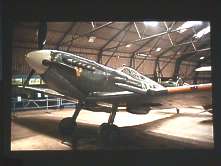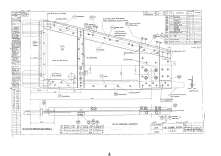
Supermarine Spitfire
| Spitfire Mk.IX |
| The Spitfire certainly needs no introduction, being one of the most succesful fighters of World War II. It evolved through the initial Mark I version (900 hp, 2-bladed wooden prop) into the highly sophisticated 2000 hp+ Mark 24 with 5-bladed propellor. In its last versions, the rear fuselage was cut down to allow the pilot an uninterrupted view from beneath its teardrop canopy. The tail had been gradually enlarged to counteract the massive engine power, twice as much as originally envisaged. Yet, with all modifications introduced during the Spitfire's production period, the pleasant handling qualities and exceptionally good looks remained. |
| Spitfire Mk.XIV |
| The final Spitfire variants, the air force Spiteful and navy Seafang were outclassed by the new generation of jet-powered fighters and saw only limited use. Thus ended the production of what surely ranks as one of the most beautiful fighter aircraft ever. |

|
Supermarine Spitfire Mk.V G-AWII, AR501
This nicely maintained Spit is operated by the Shuttleworth Trust at Old Warden, England.
(bottom picture provided by Stef De Wit) |
 |
Supermarine Spitfire Mk.IX SM-32, Belgian Air Force (1950) The Belgian Air Force started flying Spits immediately after the war and continued to use them as advanced trainers into the 1950's. |
 |
Supermarine Spitfire Mk.IX, Israeli Air Force After the war, the Spitfire saw service in several air forces, including that of the fledgling Israeli state. |
 |
Supermarine Spitfire LF Mk.IXb H-68, Dutch East Indies Air Force No.322 Sqn (1948) What else is there to say on this Spit, except that it looks great even in these dull colors ? |

|
Do you own, operate or maintain a Spitfire ? Copyzone Archiving Ltd has scanned all kinds of Spitfire construction drawings. In conjunction with the Lincolnshire Lancaster Association, over 2500 drawings can be purchased over the web. All drawings can be searched in an online database and can be delivered either in digital format or as paper copies. On top of that, cd-roms, containing all kinds of construction drawings, are available for individual Spitfire marks. Are you a serious Spitfire modeller ? Copyzone Archiving Ltd has several posters and drawing packages on offer, specifically aimed at the model builder. Need more information ? Check the Spitfire restoration website. (Note : the scanned drawings on offer by Spitfirerestoration are in high-quality TIF-format and are of much better quality than the reduced-size low-resolution JPG samples shown here) |
If you entered this page directly and want to check out the rest of my website : click here to go to my Homepage . |
Last update : 17-01-03 (c) Guido Van Roy